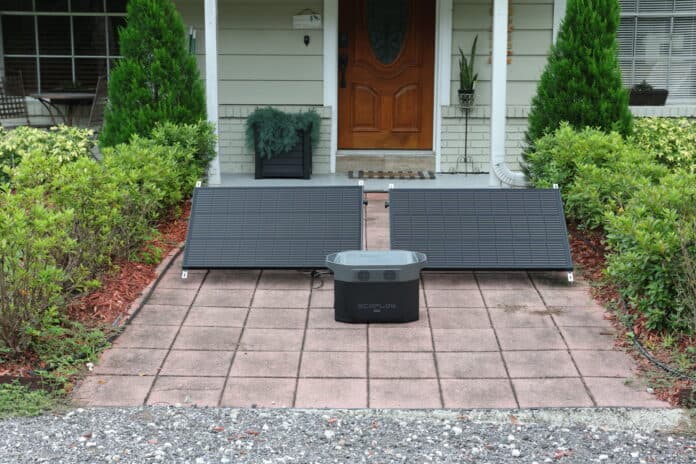A backup generator is invaluable if you want to keep the lights on during a blackout. Home backup generators provide peace of mind in areas prone to outages. Some options, like solar backup generators, even provide year-round power to off-grid builds.
To calculate the proper size required to power your home, you must consider home square meterage, household size, and the appliances you want to run. Here, we’ll go through all the factors and the different types of generators so that you can find reliable home backup power.

Factors to Consider When Choosing a Generator
How Big Is My Home?
The square meterage of your home significantly impacts the size of the generator you will need. Home size heavily affects overall energy use, especially for air conditioning and heating systems — two appliances that use a lot of energy.
Generally, the larger a home, the more watts it uses. The average Canadian household consumes around 31 kWh of electricity daily, but this can vary wildly depending on your family’s habits.
What Do I Need My Generator to Power?
The size of your generator will depend on what you hope to run during a blackout. To help you estimate your usage, here are some approximate energy consumption figures (in Watts) for some common household appliances:
- Incandescent Lightbulb: 60W-100W
- LED Lightbulb: 6W-12W
- Refrigerator: 150W-400W
- Dishwasher: 1200W-2400W
- Washing machine: 300W-500W
- Microwave oven: 600W-1200W
- Television: 50W-400W
- Computer and monitor: 100W-400W
- Hair dryer: 800W-1800W
What Are the Different Types of Generators?
There are four main types of generators: fossil fuel, inverter, solar, and whole-home.
Fuel Generators
Fossil fuel generators are the oldest and most common type. They use different fuel types, including propane, natural gas, and diesel. Whether you install a standby fuel generator or use a portable one, you’ll need to set it up outside the home at a minimum distance of 20 feet (6 meters) to ensure that toxic fumes don’t enter the house.
Depending on its output capacity, a fossil fuel generator can power almost any household appliance, including refrigerators, air conditioners, power tools, lighting, televisions, and other electronics.
You can also use them to run larger appliances like washing machines and dryers in the case of a power outage. The number of appliances a fuel generator can power simultaneously depends on its size, power output, and your fuel supply.
Typically, fossil fuel generators that run on gas or diesel can only run at full throttle, regardless of how much electricity you use. This means that fuel costs can add up quickly.
Gas prices are also notoriously unstable — and so is the fuel itself. You can only store gasoline for short periods before it becomes unusable. Also, keeping large amounts of gas in your house is unsafe (and sometimes illegal).
Propane is easier to store and a more efficient — and cleaner — alternative fuel source.
Inverter Generators
Inverter generators are a subcategory of fuel generators. Inverter devices can throttle their power generation (and fuel consumption) as needed, so they’re not always running at full blast. By regulating energy production to meet only your consumption, you can reduce noise and pollution.
An inverter generator can power the same appliances as a typical fuel model, but its stable output makes it more suitable for sensitive electronics.
Solar Generators
Solar generators are a clean-energy, noise-free alternative to traditional fuel generators. Solar technology has come a long way in recent years and is now an affordable alternative to fuel generators.
Solar generators combine a portable power station, like the DELTA Pro, with photovoltaic solar panels. The solar panels generate electricity and store it in the power station.
Smaller solar generators can power many household appliances, including lights, power tools, televisions, laptops, and other electronics.
Larger systems, such as the EcoFlow Smart Home Ecosystem, can power all appliances, including washers, dryers, ACs, and dishwashers.
You can even consider the extremely powerful and expandable DELTA Pro Ultra, which starts at 6kWh but expands to a whopping 90kWh capacity and boasts an impressive 7.2-21.6kW continuous AC output. You can add up to 42 400W Rigid Solar Panels to achieve 16.8kW of solar charging potential!
Whole House Generators
A whole house generator powers an entire home during a power outage. Some whole home generators that support solar charging can provide year-round power to off-grid homes, such as EcoFlow’s Whole Home Power Backup Solution.
A whole home generator can run any standard household device or appliance, including power-hungry appliances like washing machines, dishwashers, and heating/cooling systems.
How Much Power Do Appliances Need To Start?
When selecting a generator, it is crucial to consider the starting power (also called surge power) requirements of your appliances and electronics. For some appliances, the surge watts maybe two to three times higher than the running watts. A 700-watt refrigerator, for example, may require 2200 watts of surge power at startup.
Starting and Running Watts of Typical Household Appliances
| Appliance | Rated (Running) Watts | Starting Watts |
| Dishwasher | 1300 | 1800 |
| Washing Machine | 1200 | 2300 |
| Refrigerator/Freezer | 700 | 2200 |
| Light Bulb | 60-75 | 0 |
| Microwave | 600-1000 | 0 |
| TV | 500 | 0 |
| Toaster | 900 | 0 |
| Vacuum | 1440 | 2500 |
| Coffee Maker | 1000 | 0 |
| Blender | 300 | 800 |
| Clothing Iron | 1500 | 0 |
| Dryer | 5400 | 7000 |
| Toaster Oven | 1200 | 0 |
| Curling Iron | 1500 | 0 |
| Space Heater | 2000 | 0 |
| Laptop | 50-300 | 0 |
| 20” Box Fan | 200 | 350 |
The generator’s surge output capacity should be sufficient to power the device or appliance with the highest surge power. One quick way to calculate how much power output you need is to consider the appliance in your home with the highest starting wattage and select a generator that can provide surge power higher than that device.
A solar generator’s power output is usually listed in watts (W) or kilowatts (kW). For example, EcoFlow’s DELTA Pro has an operating power output of 3.6K kW (3600W).
Thanks to EcoFlow’s proprietary X-Boost technology, the DELTA Pro can briefly output surge power of 7200W to get even the biggest home appliances up and running.
Why Is It Important To Have the Right Size Generator?
Having a generator with sufficient power output capacity for your home is vital for a few reasons, including safety, efficiency, reliability, and performance.
- Safety: Running high-wattage appliances with a generator with insufficient capacity can cause a generator overload, potentially damaging your appliances or the generator. In some situations, it may even create a fire hazard. Many small generators will have a maximum power rating below larger household appliances, such as refrigerators, drying machines, and air conditioning units.
- Efficiency: An oversized fossil fuel generator will consume more fuel and cost more to operate than necessary. Many gas generators can’t throttle their energy production—it’s either all or nothing. Solar generators do not have this issue.
- Reliability: A properly-sized generator will provide consistent and reliable power during outages. If you purchase an undersized generator, you run the risk of running out of power in the middle of a blackout.
- Performance: An appropriate generator can handle all the essential electricity requirements of your home and its appliances, ensuring that everything continues to function during an outage.
Frequently Asked Questions
The generator size needed for whole-home backup depends on the daily energy usage of the house and the backup power requirements. A general rule of thumb is to select a generator with a capacity of at least 50% of the house’s peak energy usage.
Yes, you can run your whole home on a portable generator, but it depends on its output capacity, storage capacity, and your energy consumption. A high-capacity solar generator like the DELTA Pro has an expandable capacity that lets you power an entire household with up to 25kWh of storage capacity while remaining portable and compact.
The generator size for a 230 square metre home depends on household energy usage. As a rough estimate, a 230M2 home typically uses around 30 kilowatt-hours (kWh) per day. Connecting the EcoFlow Power Kits with two power hubs and six 5kWh LFP batteries can meet this demand.
Final Thoughts
Choosing the right backup generator can be a daunting task with so many types and sizes of generators. It may take some consideration and calculation to choose the right one.
You can’t go wrong with a solar generator if you want clean, noise-free, and reliable whole-house backup power. Shop with EcoFlow. Our range of portable power stations and solar panels lets you build a backup generator tailored to your household energy needs. Our innovative products are making clean, green energy accessible to everyone.
